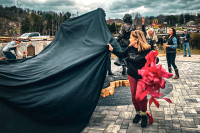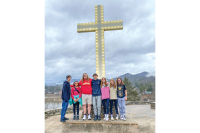Take only pictures, leave only footsteps: Outdoor photographers hone the craft of capturing the Smokies
 They stood in a line, trigger fingers poised, eyes fixated on the target.
They stood in a line, trigger fingers poised, eyes fixated on the target.
It was early morning, and the predawn sun had not yet peaked over the tops of the eastern range. An antlered male elk had his head down, buried in the tall, dew-covered grass, oblivious to the stakeout at the far edge of the meadow.
The line waited, growing impatient.
“Hold it like a gun,” whispered Bob Grytten, the leader of the group, to an inexperienced member. The young man switched his grip until Grytten was satisfied. “You always must be ready to shoot.”
Related Items
Finally, the target lifted his head above the grass.
“That’s your shot,” he said.
The line began to fire, shooting in rapid succession.
The elk turned toward the group for a moment then began to lumber west toward the edge of the woods. The click-click-clicks from the cameras increased in frequency as the elk walked.
“Take a lot of shots to get on photo when his knees are bent,” offered Grytten. “That will give the appearance of movement. It changes the whole feel.”
Then the elk lowered his head and began eating more grass. The line of photographers became impatient again; their prime shooting opportunity had ended for the moment.
Cataloochee Valley, home of the Great Smoky Mountains elk herd, is one of Grytten’s favorite sites for on-location photo outings. As a photography instructor based in nearby Waynesville, Cataloochee frequently plays a starring role in his line-up of field outings and workshops, and how could it not? The idyllic high-elevation valley sports not only stately elk but historic farm houses, misty meadows and mountain peaks.
Grytten is a guru of light, and consequently it is the biggest take-away for any photographer who comes up through the ranks of his field outings.
“It’s all about light; nothing about the subject,” he said. Grytten went on to explain the reasoning behind a morning shoot as opposed to a midday one: the colors are warmer and the yellows and reds are more brilliant. He called it the sweet light. By midday, the sun illuminates the water particles in the air, and the world becomes bluer.
Also in the morning, there are features like mist in the air that make a photograph appear more natural.
Grytten pointed out that there are distinctive advantages to shooting photographs in the Appalachian Mountains as opposed to Florida, for example, where he lived for 30 years prior to moving here. The topography of the mountains extend the morning and the evening time, and even in midday, it’s possible to steal a good shot because there are more options of either shade or the sun.
“When the sun comes up in Florida, there aren’t many options at all,” Grytten said.
Grytten has traveled all around the world taking pictures, and when he mentions any of them, he remembers what the light was like there.
In southern France the light paints the world in pastels; in Utah, the rocks and the world are red; and in Cataloochee Valley when the sun strikes just right, it turns the mist to gold.
Although Grytten is a professional with several of his photographs published, most of the members attracted to his outings are accomplished and knowledgeable photographers themselves. Several sign up for Grytten’s sessions and workshops season after season, enjoying the camaraderie of the other photographers almost as much as the instruction.
One woman, Debbie Rotolante, who was out with Grytten for the first time that day, admitted to having more than 50,000 pictures saved on her computer. She has a house in Maggie Valley and sells school uniforms for a living, but photography is her passion.
“I’ve never sold a picture,” she said. “But then it would be work.”
Once, on a two-week trip to Costa Rica, she snapped more than 4,000 photographs. By the time she returned to the United States, she had neck pains from tilting back and pointing the camera at birds, monkeys and other critters in the canopy.
She takes photography classes and trips as a chance to learn and meet other people interested in the same pursuit.
The small group of participants on the outing that day scattered up and down the road that winds through Cataloochee Valley, each pursuing their own particular shot. Grytten chased down each of them, offering advice and wisdom.
“The more you look; the more you see; the more you shoot,” he said.
To another, he explained why it was important to take pictures of objects in odd numbers — threes and fives — so as not to confuse the eye.
He instructed another to take a picture of the light as it was just peaking over the mountaintops.
“It’s smashing,” he exclaimed.
Several decades of photography have given Grytten an inexhaustible wealth of knowledge.
In 1987, Grytten was looking for a career path. To guide him in his choice, he took an aptitude test. The result indicated he would be fit for a job in the sciences or photography. Not wanting to return to school, he chose photography and became a photo-illustrator.
Three months later, he published his first work.
During the years, he developed his own style as well. After photographing an inch worm, Grytten became fond of nature macro photography — zoomed in pictures of bugs, frogs and whatever else he encountered. He snapped a majority of his photos with a 300 millimeter fixed focal length lens.
He explained his philosophy on photography was to get close to show people the detail they wouldn’t ordinarily see.
“A picture of a bird’s foot instead of a picture of the bird,” he said. “It takes it to a different dimension.”
After settling in Western North Carolina 12 years ago, Grytten began teaching photography to supplement his career.
One of the photographers on the Cataloochee outing last weekend, Duke Miller, has been going on field shoots and workshop with Grytten on and off for five years.
Miller had studied photojournalism in college but didn’t get enthusiastic again about photography until the digital age. Now, he’s retired and enjoys the outings and classes put on by Grytten. Grytten calls the group of photographers who take his classes the Lens Luggers, a club of sorts since some return more than once for his programs.
One reason some sign up for Grytten’s Lens Luggers workshops time and again: it motivates you to get out there and shoot, especially when it comes to that coveted predawn camera work. Knowing a van full of other photographers are expecting you at the appointed rendezvous spot helps keep you accountable to your craft.
On any given excursion, a group of five people in the same area will each come away with unique pictures.
“The good thing about Lens Luggers is everyone has different skills and interests than yourself, and you learn from them,” Miller said.
The Lens Luggers outings are followed up by critiquing sessions of each other’s pictures after they have been edited by computer software and touched up. But, as Grytten explained, no editing software can make up for not getting good shots in the field.
“Garbage in — garbage out,” Grytten said. “When you catch a moment in time, that’s the difference between the voice in an image and just a documentary shot.
Get your cameras and go
Outdoor photography excursions and indoor editing workshops are periodically offered by photographer Bob Grytten and his group the Lens Luggers. The classes are geared toward all experience levels and typically include carpooling to photgenic destinations, and one-on-one feedback from Grytten. A list of planned events is available at the Lens Lugger website, www.lensluggerworld.com, and the all-day programs can cost around $50, including food and transport. Many of the outings meet near Waynseville. For more information contact Grytten at This email address is being protected from spambots. You need JavaScript enabled to view it. or 828-497.3598.









